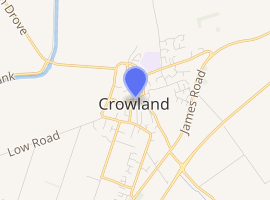Trinity Bridge, Crowland
Trinity Bridge is a unique three-way stone arch bridge that stands at the heart of Crowland, Lincolnshire, England.[1] While it once spanned the confluence of the River Welland and a tributary, the rivers have been re-routed and it now spans nothing significant.
Trinity Bridge | |
|---|---|
The triangular Trinity Bridge stands on dry land | |
| Coordinates | 52.6757°N 0.168281°W |
| Carries | pedestrians |
| Crosses | formerly the River Welland and a tributary |
| Locale | Crowland, Lincolnshire, England |
| Heritage status | Grade I listed |
| Characteristics | |
| Design | three-way arch bridge |
| Material | stone |
| No. of spans | depends how you count them |
| Piers in water | 0 |
| History | |
| Construction start | 1360 |
| Construction end | 1390 |

| |
History
The current bridge dates to the 14th century (built between 1360 and 1390) and replaced previous wooden bridges. The earliest known mention of the bridge is by King Æthelbald of Mercia in 716. In 943 it was mentioned in a charter of Eadred.[2] The bridge is now a scheduled monument and Grade I listed.
The bridge is predominantly built from Barnack stone, which was quarried about 16 km to the west of Crowland, and presumably transported by boat on the Welland.
This bridge has three stairways that converge at the top. Originally it spanned the River Welland and a tributary that flowed through the town, although the rivers have been re-routed and no longer flow anywhere near the bridge. The bridge was an unusual and economical solution to the crossing of two watercourses at their confluence, reducing the need for three separate bridges to a single structure with three abutments.
Dry Bridge in Zrenjanin, Serbia, is another example of a bridge no longer crossing water, but it is far larger.
References
- Historic England. "Trinity Bridge (352293)". PastScape. Retrieved 17 January 2011.
- Quoted in: Wheeler M.Inst.C.E, William Henry (1896). A History of the Fens of South Lincolnshire, being a description of the rivers Witham and Welland and their estuary, and an account of the Reclamation, Drainage, and Enclosure of the fens adjacent thereto. (2nd ed.). J.M. Newcombe (Boston), Simpkin, Marshall & Co. (London). p. 313. doi:10.1680/ahotfosl2e.50358.
External links
- Tourism article on Crowland
- Historic England. "Details from listed building database (1064508)". National Heritage List for England.
- Report on the repair and stabilisation of Trinity Bridge
- Trinity Bridge at Structurae
| Wikimedia Commons has media related to: |